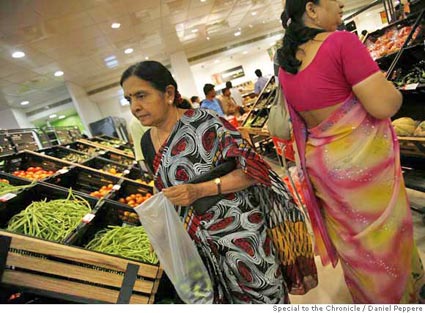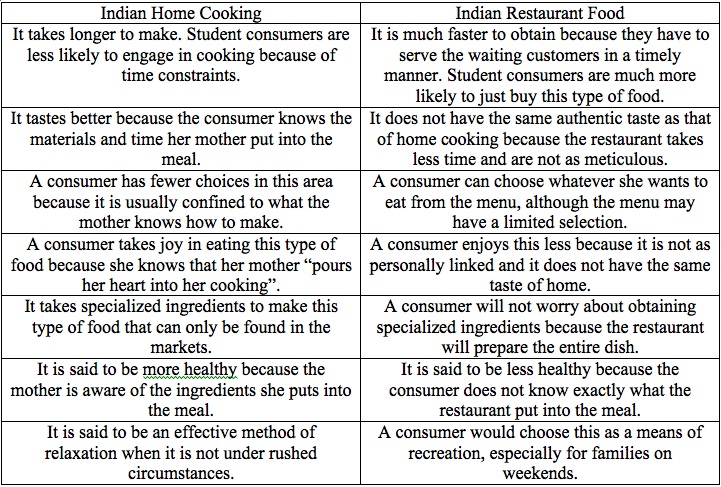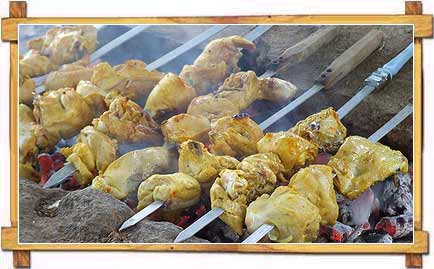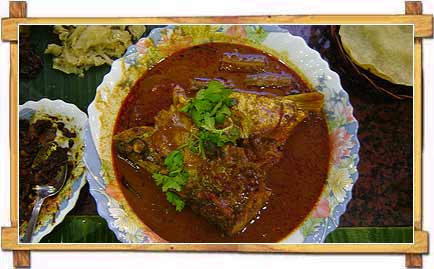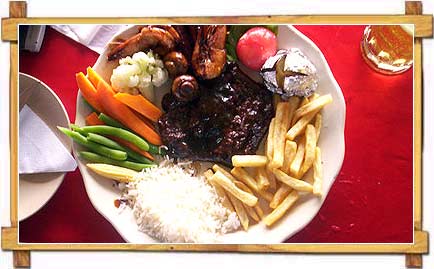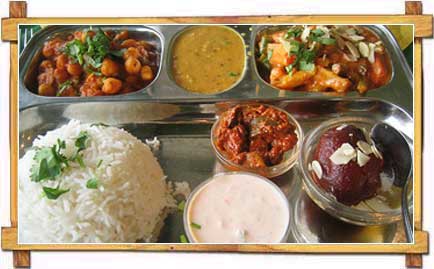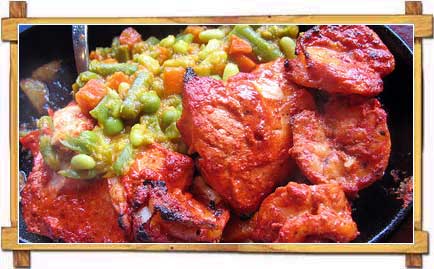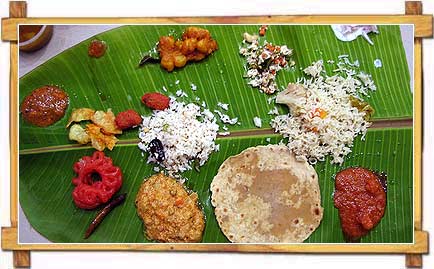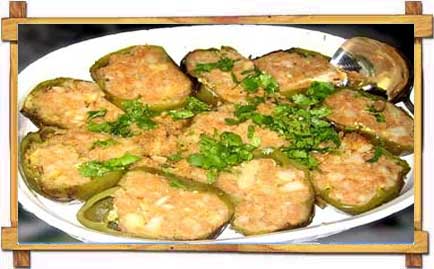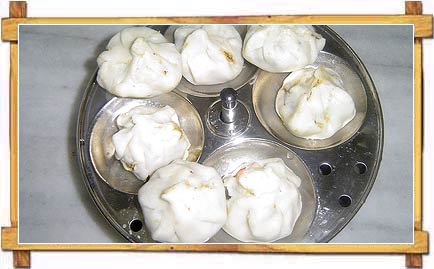From The Peopling of New York City
Food as a Symbol of Identity and Culture
Every ethnic group defines itself by its cuisine to some extent. Consequently, it can be said that Indian cuisine is a part of the way Indians identify themselves. Indian cuisine is mostly spicy and involves a great deal of meticulous planning. Indian cooks in the family are able to find the materials they need to prepare their meals in the gastronomical hubbub of Jackson Heights. There, they are able to find the cooking ingredients needed to produce their signature spicy food from the grocery and spice shops. Some of these stores include Patel Brothers, Gram Bangla Grocery, Subzi Mandi Grocery, Dhaka Kabab & Biryani House, Khaamar Baari, and Halal Meat & Fish & Grocery. These shops offer an assortment of fresh produce and condiments. Distinctively South Asian seasonings include green chili pepper, gourds, fenugreek leaves, tamarind pods, tiny eggplants, and seasonal mangoes. According to "From the Ganges to the Hudson," the shelves of these stores are filled with rice, lentil, spices, sugar, and sacks of wheat flatbread. Other stores shelve dry snacks, jars of butter, cans of Indian vegetables, fruit, and jars of spicy vegetable pickles (Lessinger 1995:33). While it might seem convenient to obtain authentic ingredients from the food shops that are all located in the Jackson Heights area, it is expected that Indian women put time into making their own fresh ingredients, grinding their own spice mixtures and spice pastes, for instance. Indians prefer fresh ingredients to frozen materials because it demonstrates that the woman has put effort, and love, into a wonderfully prepared meal. However, since Indian immigrant women often work here, they have less time to make things like their own pickles and must buy more once-homemade items in the shops. Thus these shops receive much more clientele than those that sell the same items in India. In addition, Indian immigrant women also buy other prepared foods that women in India are now beginning to purchase (Lessinger 1995:33).
Home Cooking versus Restaurant Food
- This information is based upon Transcript of Interview with Kanushree Jain , Transcript of Interview with Shruti Vyas , and Transcript of a Continued Interview with Shruti Vyas.
Taste and Enjoyment of Different types of Indian Food
- Indian food cannot be considered merely Indian food, for India is made up of many regions. Subsequently, each region has its own specific cuisine. For example, North Indian food is generally based on bread or roti while South Indian food is mainly rice. However, although Jackson Heights is considered Little India, it does not contain the various types of Indian cuisine. Instead, the regional Indian cuisine that is most prevalent among Jackson Heights is Delhi cuisine. This section provides more information on some regional foods based on Cuisine Guide of India (http://www.shubhyatra.com/guide/cuisine-india.html).
~Nawabi Cuisine
Praised from the centuries for the richness of their dishes, Nawabs of still aspire to refine the quality of their cuisine. The popularity of Nawabi cookery didn't remain restricted to their palaces but traveled far, far away. For example, the aroma of these dishes have journeyed to the entire sub-continent and became the sovereignty of the state. Ranging from the simple every day fare to rich, elaborate banquets, the Uttar Pradesh cuisine has absorbed and adapted a variety of cuisine's to create an entire smorgasbord of wonderful dishes. The tastes of Nawabs include the Zamin Doz Machli prepared with a very complex process and need to have the patience to taste such a dish.
~Awadhi Cusine
Awadhi cuisine has the specialty of creating the tongue tickle simply with its aroma, to taste it one should have a big appetite. This cuisine is mostly prepared on the cream and lot of dried fruits. This region's delicacies would consist of elaborate dishes like kebabs, kormas, biryani, kaliya, nahari-kulchas, zarda, sheermal, roomali rotis and warqi parathas. The richness of Awadh cuisine lies not only in the variety of cuisine but also in the ingredients used like mutton, paneer, and rich spices including cardamom and saffron. In addition, The cuisine consists of both vegetarian and non-vegetarian dishes.
~Rajasthani Cuisine
Rajasthan's Rajput nobility and trading Marwari community both developed very distinct cuisines. There is a difference in the Rajasthani cuisine which comes from an old and tranquil tradition, and from a culture that has helped itself to the best from its neighboring states of Sindh, Gujrat, Harayana and Punjab. One should taste the famous Rajasthani food in its various mouth-watering dishes, served sizzling hot.
~Goan Cuisine
This regional carries an unparalleled aroma of Portugal, covered with exotic Indian spices and soaked in the inescapable zest of Goa's favorite drink, fenny. Seafood, coconut milk, rice and paste are main components of Goan delicacies. The area is located in a tropical climate, filled with intense spices and flavors. Use of Kokum is another distinct feature. Goan food cannot be considered complete without fish. Goan cuisine is similar to Malvani cuisine.
~Delhi Cuisine
Delhi Cuisine comes from the Moghul Emperors. Without having a unique taste of her own, Delhi food still has an international reputation. However, it must also be said that the Mughal rulers have had a great impact on Delhi cuisine. The influence of the Mughal rulers who ruled India is perhaps most felt in their food. A major contribution towards this is the tandoor which is an earthen oven that used to make rotis and kababs. Kababs are pieces of meat marinated in spices and skewered over a coal tandoor. Some of the famous Mughlai dishes include tandoori chicken, seekh and boti kebab and even tandoori fish. Mughlai food has a very rich taste. Its sauces consist of curd, cream and crushed nuts like cashew.
~Cuisine of Kerala
Kerala cuisine revolves around discoveries, aromas and colors. There is no doubt that Kerala has several culinary traditions, both region and religion specific, but there are two things that gives Kerala cuisine an edge over others; its repertoire and undoubtedly coconut. A great emphasis is laid on the ingredients used, the vessels it is cooked in and strangely, the nature of fire used. The beauty of this Malayali food is that, it offers a true taste of nature, a perfect amalgamation of the real with the imagined. Kerala cuisine consists of rice-flavored by the soil it has grown in, seasonal vegetables carrying morning dew on their skin-fresh from the garden, fish straight from the backwaters, spice that bears within, and the fiery heat of the sun. It is about countless flavours - coconut oil, mustard seeds, curry leaves, tamarind paste, asafoetida and chillies - each one of which rejoice a special place in the Malayali's palate.
~Cusine of Madhya Pradesh
The cuisine of the state is impacted by Rajasthani and Gujarati influence. The traditional Malwa food, has a palatable quality and essence of Gujarati and Rajasthani cuisine. Jowar which was the staple food has now been overshadowed by the use of wheat. As the land is dry and unproductive for most of the year, the use of vegetables regulated. One can differentiate the Madhya Pradesh cuisine from the others due to the free use of spices, oil and seasonings.
~Kashmiri Cuisine
Essentially non-vegetarian, the cuisine of Kashmiri is popularly known as Wazwan and the cook is known as Waza. These wazas claim to be the descendants of the master chefs who migrated from different parts of central Asia to Kashmiri in the 15th century at the time of the Timurlane reign in India.
~Kannadiga Cuisine
Every part of Karnataka has a unique culinary tradition to brag. The Mangalorian cuisine platter is full of spices and is generally rice based. Fruits, fresh coconut and chillies are an integral part of Mangalore food. The most renown specialty of this region is steamed stuffed colocasia leaves. The Akki rotti, or rice rotti of Mangalorian cuisine is also popular in Malnad and Kodagu. One may try the famous Masala Dosa to get a taste of the Udupi region of Karnataka, where this dish originated. The food here is strictly vegetarian and is stripped of onion and garlic. The Kodagu region on the other hand has a very distinct variety of food items that includes a lot of non-vegetarian dishes.
~Cuisine of Himachal Pradesh
The daily food of the Himachali is very similar to that of the north Indian. A typical everyday meal will include the usual Daal – Chawal – Subzi and roti. The common north Indian meal of rice, lentil broth, dish of vegetables and bread, with sometimes non vegetarian creeping in the menu list. The main preparation of food includes the locally-grown coarse grains like buckwheat, millet and barley. In Himachali food, the use of spices like cardamom, cinnamon, cloves and red chillies is currently popular.
~Marati Cuisine
The State of Maharashtra is famous for its culinary genius as well as for its tastes. Some of the best Maharashtran dishes are Puranpoli, Ukadiche Modak, Gulpoli, Laddoos, Basundi, Chakali, Zunaka bhakari, Shrikhanda, Bartiwangi, and Dalimbi Usal. The delicacies of Mahashtra also includes the traditional snacks of the state, the Chaat and pani puri. Then, there is the quintessential vada-pav and potato pohe made from rice flakes, onions and spices. Kanda- pohay or onion pohe is a favorite dish for marriages in Maharastra. Other than that, there is Khandvi, a gram-flour based spicy snack, and other rice lentils based snacks that are extremely tasty. Another favorite is the famed misal-pav, a spicy mix of lentils, which is topped with batata-bhaji, poha, sabudana khichadi and chivda. This dish is sometimes eaten with curd.
